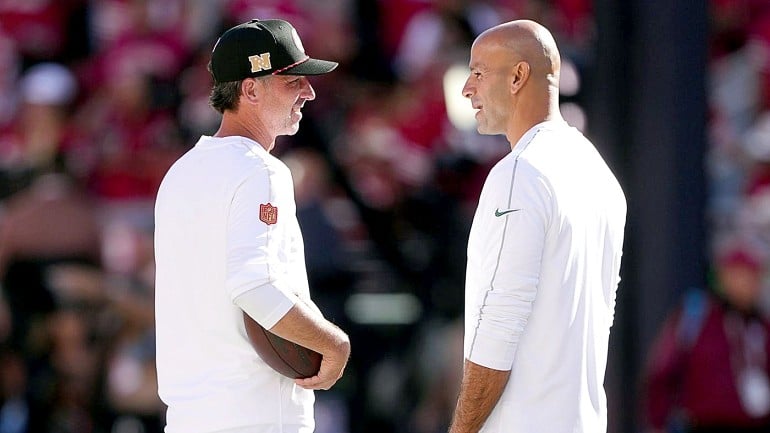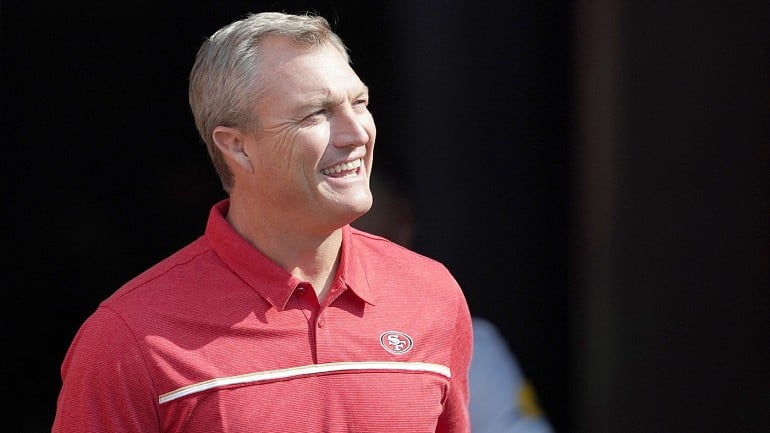San Francisco 49ers head coach Kyle Shanahan coached the NFL's best offense in 2016. We dig into the statistics, which tell us that in Shanahan's offense, first down is the most important down.
When the San Francisco 49ers signed head coach Kyle Shanahan to a six-year contract, they believed they signed a coach who was both a leader and an offensive genius. Shanahan will continue to grow as a leader with the 49ers, but he has already established himself as one of the top young offensive minds in the game today. In 2016, Shanahan's Atlanta Falcons offense led the league in total points scored, points-per-drive, yards-per-play and Football Outsiders' DVOA. Shanahan has always been a successful coordinator -- he's coached top-10 offenses in six of his nine seasons -- but in 2016, his offense was truly elite. What made his 2016 offense the best in the NFL?
The Falcons' 2016 offense was the NFL's top offense because it was two things: balanced and explosive.
At first glance, these two factors seem at odds with each other, but the opposite is true; Shanahan's offense is so explosive because it is so balanced.
Ask the average NFL fan why the Falcons' offense is so potent and you'll be told that the Falcons are a great running team, and their running game opens up deep passes to Pro Bowl wide receiver Julio Jones. There is some truth to this; the Falcons do run the ball fairly well, and the play-action pass is an essential part of Shanahan's passing attack. In 2016, over a quarter of the team's passes were play-action passes, which lead the NFL -- as did quarterback Matt Ryan's 1,600 play-action passing yards. However, Jones wasn't the only receiver to benefit from the Falcons' play-action game, as two-thirds of Ryan's play-action passing yards went to other receivers. Jones is certainly one of the best receivers in the game, but the Falcons were more balanced in 2016. In 2015, Jones had a 33-percent market share of Ryan's targets. In 2016, his market share was 24-percent, which resulted in 22-percent of the Falcons' receptions, for only 16-percent of the Falcons' receiving touchdowns.
How could Julio Jones only score six touchdowns when the Falcons scored more points than any other team in the league? Not only was Shanahan's offense balanced between the 20s, they were also balanced in the red zone, which resulted in an NFL-record 13 different players with touchdown receptions. Even within the 10-yard line, Jones wasn't the most targeted Falcon -- wide receiver Mohamed Sanu's 24-percent target market share was the highest on the team. Jones had a 15-percent market share with nine targets -- the same as 5-foot-10 Justin Hardy, and only one more than 5-foot-8 Devonta Freeman. For comparison, when the 2016 Jacksonville Jaguars were within the 10-yard line, they threw 42-percent of their passes to wide receiver Allen Robinson during their three-win, 318-point season.
So what does this tell us? Throw the ball less to Julio Jones and you'll have a more explosive team? That alone would be a poor strategy. Instead, Shanahan's target distribution is part of a broader offensive philosophy: force the defense to protect the entire field, and create situations that allow you to exploit mismatches and attack defenders who make mistakes. Shanahan's outside-zone run game is a part of this philosophy because it forces the defense to protect horizontally due to the threat of the outside run and cutback, and vertically due to the threat of the play-action pass. When a defense over-commits in one direction, they're attacked in the opposite direction, and the result is usually an explosive play. Shanahan is also balanced in the direction of his outside-zone runs; in 2016, the Falcons had 73 outside-zone runs outside the left tackle, and 79 outside the right tackle. Of those plays, 20 were explosive runs -- defined as 10 yards or more -- with 10 to the left side and 10 to the right.
The 2016 Falcons had a balanced running game -- they ran outside zone on just under half of their running plays, and they ran fairly equally to the left and to the right. They also had a balanced passing game -- Ryan spread his targets to multiple receivers and had a quarterback rating over 100 when throwing to each of the six areas of the field, from deep left to short middle to deep right. But how did this balance make their offense explosive? The answer lies in the misconception that the 2016 Falcons were a run-first team, and their running game set up their passing game. The Falcons were actually a pass-first team, and their passing game set up their running game. Shanahan's passing game was so effective -- and explosive -- because he passed when defenses least expected it -- on first down, and out of heavy sets.
Over the 2016 season, the Falcons' run-pass ratio was the 11th highest in the league. However, this ratio was skewed by the fact that the Falcons spent a large percentage of their plays running out the clock thanks to large leads -- a byproduct of scoring 540 points in a season. Over 30-percent of the Falcons' running plays came with at least a two-touchdown lead, and 55-percent were run when the Falcons were ahead by at least one touchdown. When you filter out positive game script, the stats tell a different story. When the Falcons were within one score of their opponents, their pass percentage was the seventh highest in the NFL. The numbers are even more stark on first down; when the Falcons were within one score, they threw on first down more than any team in the NFL -- including the Green Bay Packers, who played half the season with a wide receiver as their lead running back.
Shanahan's Falcons were a passing team with a number of competent receivers, but the receivers were rarely on the field at the same time. In an NFL that plays in 11 personnel 60-percent of the time, the Falcons utilized 11 personnel on only 44-percent of their offensive plays. Shanahan prefers heavier personnel; he used 13 personnel more than just two other teams, and 21 personnel more than only one. And although he prefers tight ends and fullbacks to multiple wide receivers, he doesn't use heavy sets to just run the ball. No team threw out of 13 or 21 personnel more than the 2016 Falcons; in fact, Shanahan threw out of 13 or 21 personnel more than half of NFL teams combined.
In 2016, the Falcons won because they won on first down, and they won on first down because they were balanced. Shanahan used both big and small sets, and ran and threw out of both -- Ryan was under center on 76-percent of first-down snaps, which was tops in the league and 1.5 times the NFL average. When an offense's playbook isn't limited by personnel or formation, it puts the defense at a distinct disadvantage. Defenders are forced to protect the entire field, mismatches are created, and defenders are more prone to make mistakes. This enabled Shanahan's offense to be both efficient and explosive.
The 2016 Falcons' pass efficiency and their use of heavy personnel was correlated -- generally, their pass success rate (the original "Hidden Game of Football" version, based on yardage, down and distance) was higher as they decreased the number of wide receivers they had on the field. On first down, the prevalence of big sets helped produce a gaudy pass success rate of 62-percent, led by a 70-percent pass success rate from 13 personnel. After first down, the Falcons' passing game was less successful on each subsequent down. This efficiency discrepancy carried over to the running game; Falcons running backs were also most efficient on first down and least efficient on third down, which is the opposite of the NFL average.
In 2016, Ryan led all passers with 9.26 yards-per-attempt (YPA), which was over a yard higher than every other quarterback in the league. His numbers on first down were even more impressive, especially when broken down by position group. On first down, Ryan led the league in YPA on passes to each of the three position groups, with an 11.3 YPA to wide receivers, an 11.3 YPA to tight ends, and a 10.2 YPA to running backs. By being balanced and attacking the defense with each of their position groups, 45-percent of the Falcons' first-down passes resulted in another first down. Since the Falcons threw so often -- and effectively - out of heavy sets, defenses were no longer able to key against the run, which created opportunities for the Falcons' running backs. For a team that is considered a "running team," Falcons running backs were below the NFL average in run success rate and yards-per-carry (YPC) on downs other than first down; Freeman's 3.1 YPC and Tevin Coleman's 3.4 YPC on later downs were surprisingly low. However, their overall stats were bolstered by impressive first-down YPCs of 5.4 and 5.0, respectively, thanks to opposing defenses being softened by a potent first-down passing game.
Shanahan had the most explosive passing game in football due to -- and not in spite of -- his use of heavy personnel. 12-percent of the 2016 Falcons' pass plays were "explosive" -- netting the team at least 15 yards -- which was tops in the NFL. However, the majority of these explosive plays came on first down, where 16-percent of pass plays were explosive, thanks to particularly high rates by tight ends (18-percent) and wide receivers (20-percent). The Falcons' explosive play percentage on pass plays dropped to 10-percent on second down, and dropped again to 8-percent on third down. The Falcons' running game was also more explosive out of heavy personnel; of the 20 explosive runs outside the tackles,16 of those runs came on first down.
This explosive play came on a first down, with the Falcons in 13 personnel. The Seattle Seahawks weren't prepared when Shanahan kept his lone receiver short, and sent everyone else deep on a four verticals concept:
Shanahan's Falcons in 13 personnel - RB split out. Sherman bites on short route while TEs & RB run four verts. Deep pass for the easy score. pic.twitter.com/scE0n5xzjQ
— Chris Wilson (@cgawilson) June 27, 2017
You've heard the old adage that third down is the most important down in football. Technically, this statement is true, in that third down is generally a team's last opportunity to move the chains, and therefore has the greatest effect on a team's Expected Points. Some in the football analytics world argue that first down is the most important down, because success on early downs drastically affects the team's ability to achieve a first down on subsequent downs. Kyle Shanahan's offense expands upon this argument -- if you move the chains on every first down play, you never have to worry about third downs. It's a simple strategy that's extremely difficult to execute. In 2016, Kyle Shanahan executed it to perfection, on the way to a historic offensive season.




